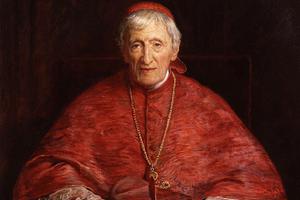Eucharistic Procession Honors Blessed John Henry Newman in London
This celebration of the blessed’s Oct. 9 feast day is a sign the militant anti-Catholicism of past years, led by fervent Protestants who believed that Catholicism was a form of paganism or idolatry, has given way to puzzled indifference.

LONDON — Since Pope Benedict XVI beatified Cardinal John Henry Newman five years ago during the first-ever state visit of a pope to Britain, British Catholics have marked the event with a Eucharistic procession through London in thanksgiving.
This year was the biggest yet: Led by a cross-bearer flanked with acolytes carrying candles and a great papal flag, it made its way from Westminster Cathedral across the Thames at Lambeth Bridge to finish with Benediction at St. George’s Cathedral in Southwark.
It is a sign of the present religious state of Britain that the procession aroused no animosity and, indeed, produced only mild gawking and some selfie-taking from passersby and tourists as it made its way through the London streets.
A century ago, such a procession was planned as the culmination of a great Eucharistic Congress held in London, but it was banned by the public authorities on the grounds that it would be too controversial and would create public disorder. No such problems seemed to emerge on today, the memorial of Blessed John Henry Newman’s beatification.
While the Church’s moral teachings are much challenged and derided — anyone in public life who openly opposes same-sex “marriage” or dares to suggest that homosexual activity might be wrong is likely to be hounded out of office or forced to make a public recantation — the Church’s sacraments and life of prayer are virtually unknown to millions.
The militant anti-Catholicism of past years, led by fervent Protestants who believed that Catholicism was a form of paganism or idolatry, has given way to puzzled indifference. Almost the only thing that most British people know about the Catholic Church is its opposition to abortion and to same-sex “marriage.”
So the sight of the Blessed Sacrament being carried through the streets beneath a canopy, attended by a great throng of people, induces not opposition, but vague bewilderment — and, for some, immediate clicking of a mobile phone to record the moment and send a picture to a friend.
The procession is known among Catholic Londoners as the “Two Cathedrals” because it links Westminster Cathedral on the north bank of the Thames with the lesser known St. George’s on the south. Westminster Cathedral, built at the beginning of the 20th century, stands in Victoria Street, which leads down to the Parliament building and the ancient abbey build by St. Edward the Confessor, which gives its name to this whole district — the Minster to the West of the old city of London.
The procession begins in the piazza outside Westminster Cathedral, which in 2010 was packed with young people who had come to meet Pope Benedict in an unforgettable gathering — and goes down Ambrosden Avenue towards the Horseferry Road. Here, for many centuries, a ferry owned by the archbishops of Canterbury was the only means of crossing the Thames — today, traffic surges along Millbank and across Lambeth Bridge, and the procession brings this temporarily to a halt as members of the Knights of St. Columba marshal the pilgrims across.
Five years on from the state visit of Pope Benedict, there are some tangible results. Some of these are obvious: from the great stone with its Latin inscription that greets every visitor through the main doors of Westminster Cathedral to the annual celebrations on the feast of Cardinal John Henry Newman, whom he beatified Sept. 19, 2010. Others are perhaps less well known but producing good fruit: St. Mary’s University at Twickenham, which he visited, now has a house named after him, where students live as a Catholic community, praying together and offering hospitality to other students.
Catholics in Britain face daily challenges to living out their faith, as do all Christians: Where churchgoing was once a normal part of the culture, it is now a minority activity. Muslims are the fastest-growing religious group; their mosques are packed each Friday with young followers, heavily veiled women are a standard part of British life, and they have large families.
Among Christians, Catholics form the largest group. There will be a good number of young Catholics from Britain at World Youth Day in Krakow next year. The widespread publicity given to Pope Francis and to events such as the synod on the family keep the Church in the news, and Catholic institutions are a major part of life, with Catholic schools being popular and over-subscribed. The number of young men responding to a vocation to the priesthood has risen slightly in recent years.
But, overall, the message for Catholics is that there are tough years ahead. The presence of Christ in the Blessed Sacrament in the London streets is a sign of hope — and of the need to trust in him.
Joanna Bogle writes from London.

















